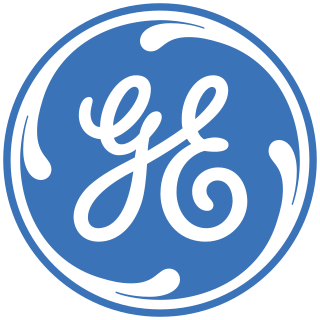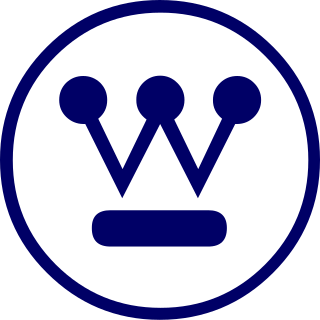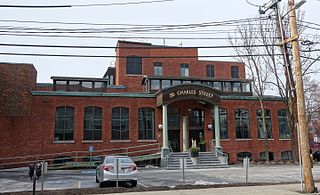
General Electric Company (GE) was an American multinational conglomerate founded in 1892, incorporated in the state of New York and headquartered in Boston. The company had several divisions, including aerospace, energy, healthcare, and finance.

Koninklijke Philips N.V., commonly shortened to Philips, is a Dutch multinational conglomerate corporation that was founded in Eindhoven in 1891. Since 1997, its world headquarters have been situated in Amsterdam, though the Benelux headquarters is still in Eindhoven. Philips was formerly one of the largest electronics companies in the world, but is currently focused on the area of health technology, having divested its other divisions.

An incandescent light bulb, incandescent lamp or incandescent light globe is an electric light with a filament that is heated until it glows. The filament is enclosed in a glass bulb that is either evacuated or filled with inert gas to protect the filament from oxidation. Electric current is supplied to the filament by terminals or wires embedded in the glass. A bulb socket provides mechanical support and electrical connections.

Artificial lighting technology began to be developed tens of thousands of years ago and continues to be refined in the present day.

Sir Joseph Wilson Swan FRS was an English physicist, chemist, and inventor. He is known as an independent early developer of a successful incandescent light bulb, and is the person responsible for developing and supplying the first incandescent lights used to illuminate homes and public buildings, including the Savoy Theatre, London, in 1881.

The Westinghouse Electric Corporation was an American manufacturing company founded in 1886 by George Westinghouse. It was originally named "Westinghouse Electric & Manufacturing Company" and was renamed "Westinghouse Electric Corporation" in 1945. The company acquired the CBS television network in 1995 and was renamed "CBS Corporation" until being acquired by Viacom in 1999, a merger completed in April 2000. The CBS Corporation name was later reused for one of the two companies resulting from the split of Viacom in 2005.

Cooper Industries was an American worldwide electrical products manufacturer headquartered in Houston, Texas. Founded in 1833, the company had seven operating divisions including Bussmann electrical and electronic fuses; Crouse-Hinds and CEAG explosion-proof electrical equipment; Halo and Metalux lighting fixtures; and Kyle and McGraw-Edison power systems products.

The National Electric Light Association (NELA) was a national United States trade association that included the operators of electric central power generation stations, electrical supply companies, electrical engineers, scientists, educational institutions and interested individuals. Founded in 1885 by George S. Bowen, Franklin S. Terry and Charles A. Brown, it represented the interests of private companies involved in the fledgling electric power industry that included companies like General Electric, Westinghouse and most of the country's electric companies. The NELA played a dominant role in promoting the interests and expansion of the U.S. commercial electric industry. The association's conventions became a major clearinghouse for technical papers covering the entire field of electricity and its development, with a special focus on the components needed for centralized power stations or power plants. In 1895 the association sponsored a conference that led to the issue of the first edition of the U.S. National Electrical Code. Its rapid growth mirrored the development of electricity in the U.S. that included regional and statewide affiliations across the country and Canada. It was the forerunner of the Edison Electric Institute. Its highly aggressive battle against municipal ownership of electric production led to extensive federal hearings between 1928 and 1935 that led to its demise. Its logo is an early depiction of Ohm's law which is "C equals E divided by R," or "the current strength in any circuit is equal to the electromotive force divided by the resistance," or the basic law of electricity. It was established in 1827 by Dr. G. S. Ohm.

Leviton Manufacturing Company, Inc. is an American manufacturer of electrical wiring equipment in North America. It produces electrical light sockets, receptacles and outlets, switches, dimmers and other lighting control systems, wire, power cables, power cords, wall and ceiling occupancy sensors, wall plates, datacom, and other electrical products.

GE HealthCare Technologies, Inc. is an American multinational medical technology company headquartered in Chicago, Illinois. It was spun-off from General Electric on January 4, 2023, with GE retaining 6.7%. As of 2017, it is a manufacturer and distributor of diagnostic imaging agents and radiopharmaceuticals for imaging modalities used in medical imaging procedures. It offers dyes used in magnetic-resonance-imaging procedures; manufactures medical diagnostic equipment, including CT image machines; MRI, X-ray; ultrasound; cath labs; mammogram; Nuclear Medicine Cameras; and develops health technology for medical imaging and information technologies, medical diagnostics, patient monitoring systems, disease research, drug discovery, and biopharmaceutical manufacturing. It was incorporated in 1994 and operates in more than 100 countries.

Sylvania Electric Products Inc. was an American manufacturer of diverse electrical equipment, including at various times radio transceivers, vacuum tubes, semiconductors, and mainframe computers such as MOBIDIC. They were one of the companies involved in the development of the COBOL programming language.

Tungsram was a manufacturing company located in Hungary and known for their light bulbs and electronics. Established in Újpest in 1896, it initially produced telephones, wires and switchboards. The name "Tungsram" is a portmanteau of tungsten and wolfram, the two common names of the metal used for making light bulb filaments. Before becoming nationalized by the Communist government in 1945, the company was the world's third largest manufacturer of light bulbs and radiotubes, after the American General Electric and RCA companies.

Mazda was a trademarked name registered by General Electric (GE) in 1909 for incandescent light bulbs. The name was used from 1909 to 1945 in the United States by GE and Westinghouse. Mazda brand light bulbs were made for decades after 1945 outside the US. The company chose the name due to its association with Ahura Mazda, the transcendental and universal God of Zoroastrianism whose name means light of wisdom in the Avestan language.
General Electric has a long history, involving numerous mergers, acquisitions, and divestitures.

Nela Park is the headquarters of GE Lighting, a Savant company, and is located in East Cleveland, Ohio, United States. Nela Park is the first industrial park in the world, and was the site of most of the lighting breakthroughs of the last century.

Edison screw (ES) is a standard lightbulb socket for electric light bulbs. It was developed by Thomas Edison (1847–1931), patented in 1881, and was licensed in 1909 under General Electric's Mazda trademark. The bulbs have right-hand threaded metal bases (caps) which screw into matching threaded sockets. For bulbs powered by AC current, the thread is generally connected to neutral and the contact on the bottom tip of the base is connected to the "live" phase.

Edward E. Hammer was an engineer who was at the forefront of fluorescent lighting research. His technological contributions in incandescent, fluorescent and HID light sources earned him over 35 patents.

Zvi Schreiber ( is a British-Israeli businessman, executive, and author. He founded high-tech startups like G.ho.st, which at the time was considered the only high-tech startup with a joint Palestinian–Israeli team. In 2011 Schreiber was CEO of Lightech which he sold to GE Lighting.

GE Canada is the wholly-owned Canadian unit of General Electric, manufacturing various consumer and industrial electrical products all over Canada.

GE Vernova Inc. is an energy equipment manufacturing and services company headquartered in Cambridge, Massachusetts. The company is a result of General Electric merging and spinning off its energy businesses: GE Power, GE Renewable Energy, GE Digital, and GE Energy Financial Services.




















